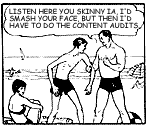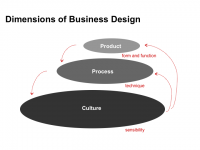Malcolm Gladwell (Blink, The Tipping Point) and Steven Johnson (Everything Bad is Good For You, Emergence) will be at the Strand in NYC to read from their books and discuss economics, social trends and other topics.
September 21, 6:30 – 8:30PM
Malcolm Gladwell (Blink, The Tipping Point) and Steven Johnson (Everything Bad is Good For You, Emergence) will be at the Strand in NYC to read from their books and discuss economics, social trends and other topics.
September 21, 6:30 – 8:30PM
My biz partner Christina is blogging again — yay! — with the usual intriguing topics. Stop reading my boring ol’ blog and go to eleganthack.com.
“We now accept the fact that learning is a lifelong process of keeping abreast of change. And the most pressing task is to teach people how to learn.” — Peter F. Drucker
 I’ll be giving a workshop at the New Challenges retreat in New York in October. I’m still massaging the format, but I want to workshop a situation where designers must use their creativity and design skills to simultaneously develop a product and its revenue source. Pencil in one hand, spreadsheet in the other.
I’ll be giving a workshop at the New Challenges retreat in New York in October. I’m still massaging the format, but I want to workshop a situation where designers must use their creativity and design skills to simultaneously develop a product and its revenue source. Pencil in one hand, spreadsheet in the other.
The music industry’s lack of innovation ability to even look at business differently is rather sad. Even after Apple showed how digital downloads could be made profitable, they’re pressuring Jobs to change his pricing model, complaining about his ingenuity…
A sore point for some music executives is the fact that Apple generates much more money selling iPod players than it does as a digital music retailer, leading to complaints that Mr. Jobs is profiting more from tracks downloaded to fill the 21 million iPods sold so far than are the labels that produced the recordings.
Andrew Lack, the chief executive of Sony BMG, discussed the state of the overall digital market at a media and technology conference three months ago and said that Mr. Jobs “has got two revenue streams: one from our music and one from the sale of his iPods.”
“I’ve got one revenue stream,” Mr. Lack said, joking that it would require a medical professional to locate. “It’s not pretty.”
No, it’s not. But why blame that on Jobs?
Dave Pollard laments that although everyone seems to agree innovation is important, few companies seem prepared to bring in someone professional to help them do it better. He offers four reasons for this:
I’ll add one more:
Link courtesy CPH.
 My wife is making a new dress for a party next month. Here’s a pic of her prototype. I love that her process resembles the basic design process: considering the desired experience, some research, investing in some materials/tools, building a prototype, testing it, marking it up, re-cutting it, testing it again, and is ready to produce the final version. All that in two evenings.
My wife is making a new dress for a party next month. Here’s a pic of her prototype. I love that her process resembles the basic design process: considering the desired experience, some research, investing in some materials/tools, building a prototype, testing it, marking it up, re-cutting it, testing it again, and is ready to produce the final version. All that in two evenings.
Maybe next time I do a workshop, instead of staplers we can make clothing. Then wearing the work will be like trigger words, reminding the participants of the rapid prototyping process.
 Max recently asked, “I’m wondering how to apply these insights in practice: How can I, as a designer, go about changing a culture that does not promote innovation…?” So I’ve been trying to isolate concrete examples to share from the times I’ve been successful.
Max recently asked, “I’m wondering how to apply these insights in practice: How can I, as a designer, go about changing a culture that does not promote innovation…?” So I’ve been trying to isolate concrete examples to share from the times I’ve been successful.
Earlier this year I taught a workshop to a department that wanted to improve their level of collaboration. A big reason they couldn’t be innovative was the lack of people working together. We formed teams and all worked to design something small and familiar enough to finish in two days: a better stapler. The collaboration, iteration, prototype making etc. we used were all new to them. At the end someone suggested coining a trigger word that would jolt them into this new way of working when they felt themselves falling into old habits.
I met my client for a coffee recently to see how they were doing. She told me the team decided to use the word “stapler” as their trigger word, and use it to spontaneously convene collaborative work sessions. Now when someone uses the trigger word, they pull themselves away from deep document writing, remember the lessons from the experiential workshop, and work in more collaborative ways.
 My partner Scott’s pretty face — arguably the second most handsome in our company — graces the front cover of this month’s Red Herring magazine. The story profiles 20 Outstanding Entrepreneurs Under 35 including great minds like Steward Butterfield and Andrew Zolli.
My partner Scott’s pretty face — arguably the second most handsome in our company — graces the front cover of this month’s Red Herring magazine. The story profiles 20 Outstanding Entrepreneurs Under 35 including great minds like Steward Butterfield and Andrew Zolli.
They would have called me first, of course, but I’m a middle-aged mogul.
Gary Hamel parallels our thoughts on management innovation…
Q: Why “management innovation”?
A: There’s a hierarchy of innovation. Economic progress is driven by three forms of innovation: institutional innovation, which includes the legal and institutional framework for business; technological innovation, which creates the possibility of new products, services, and production methods; and management innovation, which changes the way organizations are structured and administered. Management innovation has produced the most profound shifts [in business productivity].
 Recently I met with some people visiting New York from one of the big electronics manufacturers in Japan. We were talking about market opportunities and I was lobbying for a super simple mobile phone, not realizing Vodafone’s new Simply mobile phone is that phone.
Recently I met with some people visiting New York from one of the big electronics manufacturers in Japan. We were talking about market opportunities and I was lobbying for a super simple mobile phone, not realizing Vodafone’s new Simply mobile phone is that phone.
Designers, particularly the usability-focused variety, won’t have much trouble seeing the potential for this product, but that’s rarely how products get the green light. It’s helpful to see to how the Wall St. Journal describes it:
And the groupthink the CEO had to overcome to produce the phone was substantial. When requesting designs he received reactions from manufacturers “like I was from Mars” and younger Vodafone product managers kept trying to add features along the way. When it came time to develop the advertising, the CEO would show it to the product managers working on more advanced phones: “The more they hated it, the more we knew we were on the right track.”
It’s as if the CEO is a more thoughtful product manager than the product managers.
Customer research also played a role. Older customers were afraid to enter numbers in the phone and then lose it. They couldn’t adjust the volume. The designers made all the obvious design changes. But this design work was done after the company had already placed a bet on the opportunity.
Update: It’s the reverse of the RAZR story where the delivery teams had to get a working prototyping into the CEO’s hands before he saw the potential. But in both cases the CEO was key in deciding to get the product to market.
Recently I wrote about those times when a company’s strategic plans are almost inseparable from their tactical execution. I know I keep gushing about Neeleman and JetBlue, but I’m constantly impressed with how he integrates strategy and delivery. The DirecTV onboard satellite television is a good example. At the beginning his executive team was against it: it was expensive, and (beyond Air Force One) an unproven technology. But Neeleman saw the connection to his strategy and pursued it. At both the strategic and tactical levels he pushed for lean, progressive use of technology that would not only reduce costs but improve the customer experience. In this case, the medium-haul flights were too brief for movies but a perfect fit for TV. JetBlue developed a close relationship with the manufacturer to get it working right, and later bought them out. They now license it to other airlines, creating a whole new revenue source for the airline.
And as you can imagine, there are as many examples where a company doesn’t create a good fit between strategy and the points of delivery that bring the strategy to life. I summarized my thoughts on my company’s recent experiences in these cases in a new essay, Strategic Delivery Points, also available in printer-friendly PDF format.
I applaud BusinessWeek for promoting serious discussion of the social problems in China, and India as well. A sample:
A Big, Dirty Growth Engine (on polution in China)
Waking Up To Their Rights (on workers rights)
The State’s Long Apron Strings (on Chinese multinationals’ relationship to the Communist Party)
LukeW compares what’s being said about traditional business approaches vs. a design approach. It’s a handy reduction of the current writing.
And while this is certainly useful, I hope we can reach a point where business/design becomes a false dichotomy. Both columns of appoaches can simply be tools in one big business design toolbox for solving all sorts of business problems.
Google vs. Yahoo: Clash of Cultures helpfully contrasts the cultures of both companies and how culture influences future performance….
As the two giants tussle for domination of online advertising dollars, it’s increasingly clear that this tug-of-war is really a test of what kind of corporate culture an Internet company needs: Is it a by-the-numbers and increasingly Hollywood-savvy environment like Yahoo’s? Or can an intellectual playground like Google continue to grow and thrive even as it approaches $4 billion in annual revenue?
 It’s hard to agree more with the usefulness of examining the situation through this lens (and express pleasant surprise this sentiment comes from a techie site). An organization’s outward displays of innovation and operations are only symptoms of their health; culture is their heart. My business partner John gave a presentation recently making this point, illustrating the back-and-forth change ripple effect between product, process, and culture: Design [is not a] Strategy (.pdf).
It’s hard to agree more with the usefulness of examining the situation through this lens (and express pleasant surprise this sentiment comes from a techie site). An organization’s outward displays of innovation and operations are only symptoms of their health; culture is their heart. My business partner John gave a presentation recently making this point, illustrating the back-and-forth change ripple effect between product, process, and culture: Design [is not a] Strategy (.pdf).